Novel Hybrid Modified Modal Analysis and Continuation Power Flow Method for Unity Power Factor DER Placement
Abstract
:1. Introduction
- Type 3 DER unit (0 < pfDERi < 1 with lagging power factor). Type 3 DERs can provide active power and reactive power to the network. Examples of type 3 DER are a synchronous generator operated in cogeneration and gas-fired DER;
- Type 4 DER unit (0 < pfDERi < 1 with leading power factor). This type of DER provides active power to the system but attracts reactive power. An example of type 4 DER is primarily an induction generator in a wind farm, such as doubly fed induction generators (DFIG) [6].
- developing a new hybrid scheme to compute optimal DER placement. This technique is a hybrid approach between the modified modal analysis (MMA) and continuation power flow (CPF) or MMA–CPF method. This approach combines the key features of both techniques. The MMA incorporates eigenvalue computation and the correlated eigenvectors of the reduced modified voltage–active power Jacobian matrix. MMA uses eigenvectors to compute the bus active participation factor (APF). The APF provides an indication of the participation of a certain bus in solving the instability problem of the network. On the other hand, the CPF reformulates the equation of power flow by using a prediction–correction stepping algorithm to reach the solution track and computes the tangent vector sensitivity (TVS). Both APF and TVS provide indications about the bus that has the largest influence in improving the system stability directly. Thus, the load bus that has the largest APF/TVS is chosen as the place for the DER unit;
- delivering a complete evaluation of the impact of DER allocation on system losses and assessment of voltage stability, which, in this case, are the smallest eigenvalues for the system as they are a common indicator for assessing the performance of system stability;
- enhancing the objective functions based on the power losses and eigenvalues to conclude the most suitable DER site when a difference between APF and TVS occurs. Formulation of this objective function provides a calculation in which bus will provide the least losses and the most stable system.
2. Modified Modal Analysis
3. Continuation Power Flow (CPF)
4. Proposed Methodology, System Constraints, Objective Function, and Evaluation Parameters
4.1. Proposed Hybrid MMA–CPF Technique
- Step 1
- Input the system data.
- Step 2
- Execute power flow with Equation (1) and evaluate voltage stability for the original state (no DER unit) to compute voltage profile, system losses, and eigenvalue.
- Step 3
- (a) Execute MMA to compute APF at each load bus to define the most influential bus (busj-MMA), and(b) execute CPF to compute TVS at each load bus to define the most sensitive bus (busj-CPF).
- Step 4
- Compare the outcomes of MMA and CPF. If busj-MMA ≠ busj-CPF, go to Step 5; otherwise, go to Step 7.
- Step 5
- Compute , , and VSI.
- Step 6
- Compute the OF. The bus that has the highest objective function is recommended as the DER location.
- Step 7
- Set up DER in the designated bus.
- Step 8
- Execute power flow and evaluate voltage stability assessment to compute voltage profile, system losses, and eigenvalue.
- Step 9
- Assess the performance of the system as to if all the voltages are within the voltage limit constraints.
- Step 10
- If the bus voltage magnitudes are not fulfilled, then adjust the system data to acquire a new DER place and go back to Step 3.
- Step 11
- Once the voltage stability constraints are fulfilled, the program is terminated.
4.2. Voltage Stability Constraints
4.3. Eigenvalue Evaluation
4.4. Network Power Losses
4.5. Objective Function
5. Test Results and Analysis
5.1. APF and TVS Computation for DER Location
5.2. Voltage Profile Enhancement
5.3. The System Smallest Eigenvalue ()
5.4. Network Power Losses
6. Conclusions
Author Contributions
Funding
Data Availability Statement
Conflicts of Interest
Nomenclature
| APF | Active Participation Factor |
| TVS | Tangent Vector Sensitivity |
| RDN | Radial Distribution Network |
| DG | Distributed Generation |
| DER | Distributed Energy Resources |
| MMA | Modified Modal Analysis |
| CPF | Continuation Power Flow |
| MMA–CPF | Modified Modal Analysis–Continuation Power Flow |
| OF | Objective Function |
| Active power variations | |
| Reactive power variations | |
| ∆𝜃 | Voltage angle variations |
| ∆𝑉 | Voltage magnitude variations |
| J | Jacobian Matrix |
| Reduced Modified Jacobian Matrix | |
| Right eigenvector matrix of | |
| Left eigenvector matrix of | |
| Diagonal eigenvalue matrix of | |
| ith eigenvalue of | |
| ith column right eigenvector of | |
| ith row left eigenvector of | |
| Load parameter | |
| Base case active power generation at bus i | |
| Initial active power load at bus i | |
| Injected active power at bus i | |
| Base case reactive power generation at bus i | |
| Initial reactive power load at bus i | |
| Injected reactive power at bus i. | |
| A specified amount of complex power that is selected to offer suitable scaling | |
| Constant assigned for the degree of generation variation at bus i as varies | |
| Constant assigned for the degree of load variation at bus i as varies | |
| Power angle changes at bus i | |
| Vector of generator angle | |
| Vector of the bus voltage magnitude vector | |
| Complex voltages at bus i | |
| Complex voltages at bus j | |
| ijth component of impedance matrix | |
| Active power generation at bus i | |
| Active power generation at bus j | |
| Reactive power injection at bus i | |
| Reactive power injection at bus j | |
| Active power losses at initial conditions without DER integration | |
| Active power losses after integration of DER | |
| Reactive power losses at initial conditions without DER integration | |
| Reactive power losses after integration of DER | |
| Reduction in active power losses | |
| Reduction in reactive power losses | |
| Reduction percentage of active power losses | |
| Reduction percentage of reactive power losses | |
| Voltage stability index, indicating voltage stability improvement after DER placement | |
| The smallest eigenvalue with DER unit(s) | |
| The smallest eigenvalue without any DER unit |
References
- Hung, D.Q.; Mithulananthan, N.; Bansal, R.C. Analytical Expressions for DG Allocation in Primary Distribution Networks. IEEE Trans. Energy Convers. 2010, 25, 814–820. [Google Scholar] [CrossRef]
- Arief, A.; Nappu, M.B.; Rachman, S.M. Photovoltaic Allocation with Tangent Vector Sensitivity. Int. J. Energy Convers. 2020, 8, 71–79. [Google Scholar] [CrossRef]
- Daud, S.; Kadir, A.F.A.; Gan, C.K.; Mohamed, A.; Khatib, T. A comparison of heuristic optimization techniques for optimal placement and sizing of photovoltaic based distributed generation in a distribution system. Solar Energy. 2016, 140, 219–226. [Google Scholar] [CrossRef]
- Arief, A.; Nappu, M.B.; Antamil. Analytical Method for Reactive Power Compensators Allocation. Int. J. Technol. 2018, 9, 602–612. [Google Scholar] [CrossRef]
- Sirjani, R.; Rezaee Jordehi, A. Optimal placement and sizing of distribution static compensator (D-STATCOM) in electric distribution networks: A review. Renew. Sust. Energ. Rev. 2017, 77, 688–694. [Google Scholar] [CrossRef]
- Arief, A.; Dong, Z.; Nappu, M.B.; Gallagher, M. Under voltage load shedding in power systems with wind turbine-driven doubly fed induction generators. Electr. Power Syst. Res. 2013, 96, 91–100. [Google Scholar] [CrossRef]
- Swaminathan, D.; Rajagopalan, A. Optimized Network Reconfiguration with Integrated Generation Using Tangent Golden Flower Algorithm. Energies 2022, 15, 8158. [Google Scholar] [CrossRef]
- Ramshanker, A.; Isaac, J.R.; Jeyeraj, B.E.; Swaminathan, J.; Kuppan, R. Optimal DG Placement in Power Systems Using a Modified Flower Pollination Algorithm. Energies 2022, 15, 8516. [Google Scholar] [CrossRef]
- Atwa, Y.M.; El-Saadany, E.F. Reliability Evaluation for Distribution System With Renewable Distributed Generation During Islanded Mode of Operation. IEEE Trans. Power Syst. 2009, 24, 572–581. [Google Scholar] [CrossRef]
- Kumar, M.; Soomro, A.M.; Uddin, W.; Kumar, L. Optimal Multi-Objective Placement and Sizing of Distributed Generation in Distribution System: A Comprehensive Review. Energies 2022, 15, 7850. [Google Scholar] [CrossRef]
- Barik, S.; Das, D. A novel Q−PQV bus pair method of biomass DGs placement in distribution networks to maintain the voltage of remotely located buses. Energy 2020, 194, 116880. [Google Scholar] [CrossRef]
- Esmaili, M.; Firozjaee, E.C.; Shayanfar, H.A. Optimal placement of distributed generations considering voltage stability and power losses with observing voltage-related constraints. Appl. Energy. 2014, 113, 1252–1260. [Google Scholar] [CrossRef]
- Aman, M.M.; Jasmon, G.B.; Mokhlis, H.; Bakar, A.H.A. Optimal placement and sizing of a DG based on a new power stability index and line losses. Int. J. Electr. Power Energy Syst. 2012, 43, 1296–1304. [Google Scholar] [CrossRef]
- Ishak, R.; Mohamed, A.; Abdalla, A.N.; Che Wanik, M.Z. Optimal placement and sizing of distributed generators based on a novel MPSI index. Int. J. Electr. Power Energy Syst. 2014, 60, 389–398. [Google Scholar] [CrossRef]
- Al Abri, R.S.; El-Saadany, E.F.; Atwa, Y.M. Optimal Placement and Sizing Method to Improve the Voltage Stability Margin in a Distribution System Using Distributed Generation. IEEE Trans. Power Syst. 2013, 28, 326–334. [Google Scholar] [CrossRef]
- Soo-Hyoung, L.; Jung-Wook, P. Selection of Optimal Location and Size of Multiple Distributed Generations by Using Kalman Filter Algorithm. IEEE Trans. Power Syst. 2009, 24, 1393–1400. [Google Scholar] [CrossRef]
- Acharya, N.; Mahat, P.; Mithulananthan, N. An Analytical Approach for DG Allocation in Primary Distribution Network. Int. J. Electr. Power Energy Syst. 2006, 28, 669–678. [Google Scholar] [CrossRef]
- Willis, H.L. Analytical Methods and Rules of Thumb for Modeling DG-Distribution Interaction. In Proceeding of the IEEE Power Engineering Society Summer Meeting, Seattle, WA, USA, 16–20 July 2000. [Google Scholar]
- Hedayati, H.; Nabaviniaki, S.A.; Akbarimajd, A. A Method for Placement of DG Units in Distribution Networks. IEEE Trans. Power Deliv. 2008, 23, 1620–1628. [Google Scholar] [CrossRef]
- Rao, R.S.; Ravindra, K.; Satish, K.; Narasimham, S.V.L. Power Loss Minimization in Distribution System Using Network Reconfiguration in the Presence of Distributed Generation. IEEE Trans. Power Syst. 2013, 28, 317–325. [Google Scholar] [CrossRef]
- Huy, P.D.; Ramachandaramurthy, V.K.; Yong, J.Y.; Tan, K.M.; Ekanayake, J.B. Optimal placement, sizing and power factor of distributed generation: A comprehensive study spanning from the planning stage to the operation stage. Energy 2020, 195, 117011. [Google Scholar] [CrossRef]
- García-Muñoz, F.; Díaz-González, F.; Corchero, C. A novel algorithm based on the combination of AC-OPF and GA for the optimal sizing and location of DERs into distribution networks. Sustain. Energy Grids Netw. 2021, 27, 100497. [Google Scholar] [CrossRef]
- Mouwafi, M.T.; El-Sehiemy, R.A.; El-Ela, A.A.A. A two-stage method for optimal placement of distributed generation units and capacitors in distribution systems. Appl. Energy. 2022, 307, 118188. [Google Scholar] [CrossRef]
- Roy, N.B.; Das, D. Optimal allocation of active and reactive power of dispatchable distributed generators in a droop controlled islanded microgrid considering renewable generation and load demand uncertainties. Sustain. Energy Grids Netw. 2021, 27, 100482. [Google Scholar] [CrossRef]
- Lingfeng, W.; Singh, C. Reliability-Constrained Optimum Placement of Reclosers and Distributed Generators in Distribution Networks Using an Ant Colony System Algorithm. IEEE Trans. Syst. Man Cybern. Part C Appl. Rev. 2008, 38, 757–764. [Google Scholar]
- Mohamed Imran, A.; Kowsalya, M.; Kothari, D.P. A novel integration technique for optimal network reconfiguration and distributed generation placement in power distribution networks. Int. J. Electr. Power Energy Syst. 2014, 63, 461–472. [Google Scholar] [CrossRef]
- Martín García, J.A.; Gil Mena, A.J. Optimal distributed generation location and size using a modified teaching–learning based optimization algorithm. Int. J. Electr. Power Energy Syst. 2013, 50, 65–75. [Google Scholar] [CrossRef]
- Gao, B.; Morison, G.K.; Kundur, P. Voltage Stability Evaluation Using Modal Analysis. IEEE Trans. Power Syst. 1992, 7, 1529–1542. [Google Scholar] [CrossRef]
- Arief, A. Optimal placement of distributed generations with modified P-V Modal Analysis. In Proceedings of the 2014 Makassar International Conference on Electrical Engineering and Informatics (MICEEI), Makassar, Indonesia, 26–30 November 2014. [Google Scholar]
- Ajjarapu, V.; Christy, C. The Continuation Power Flow: A Tool for Steady State Voltage Stability Analysis. IEEE Trans. Power Syst. 1992, 7, 416–423. [Google Scholar] [CrossRef]
- Arief, A.; Nappu, M.B. DG placement and size with continuation power flow method. In Proceedings of the 2015 International Conference on Electrical Engineering and Informatics (ICEEI), Bali, Indonesia, 10–11 August 2015. [Google Scholar]
- Kothari, D.P.; Dhillon, J.S. Power System Optimization; Prentice-Hall of India: New Delhi, India, 2004. [Google Scholar]

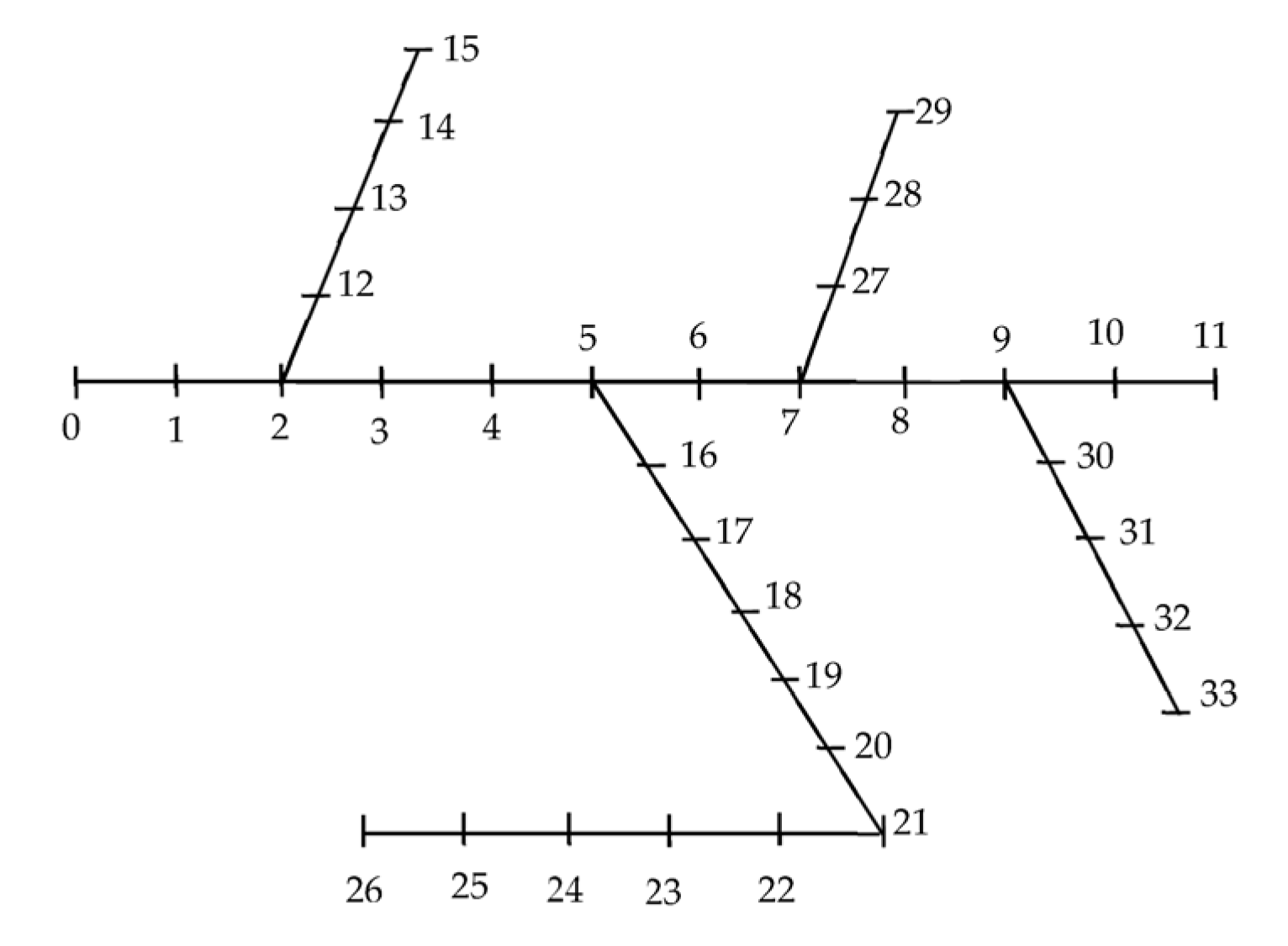
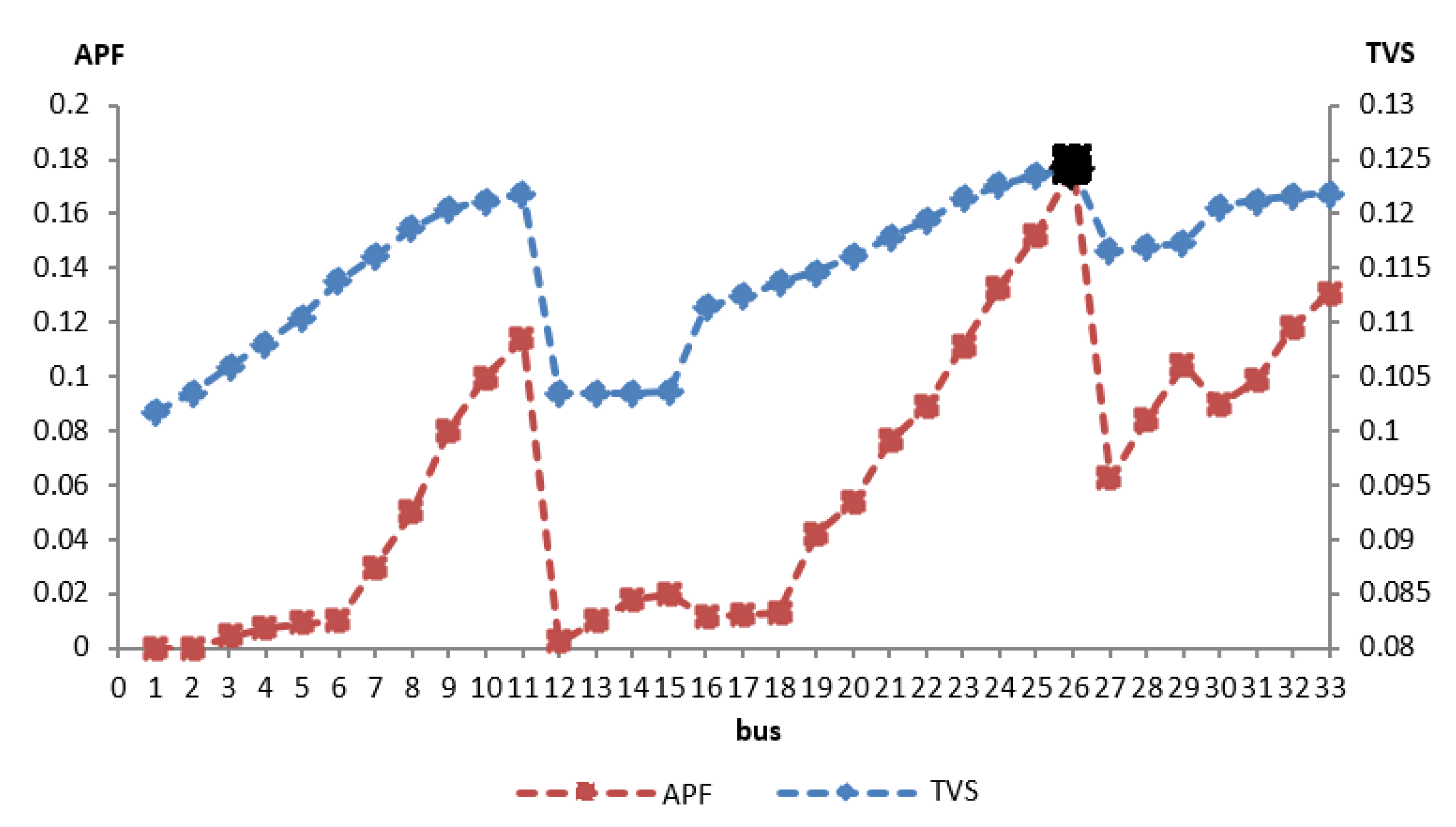
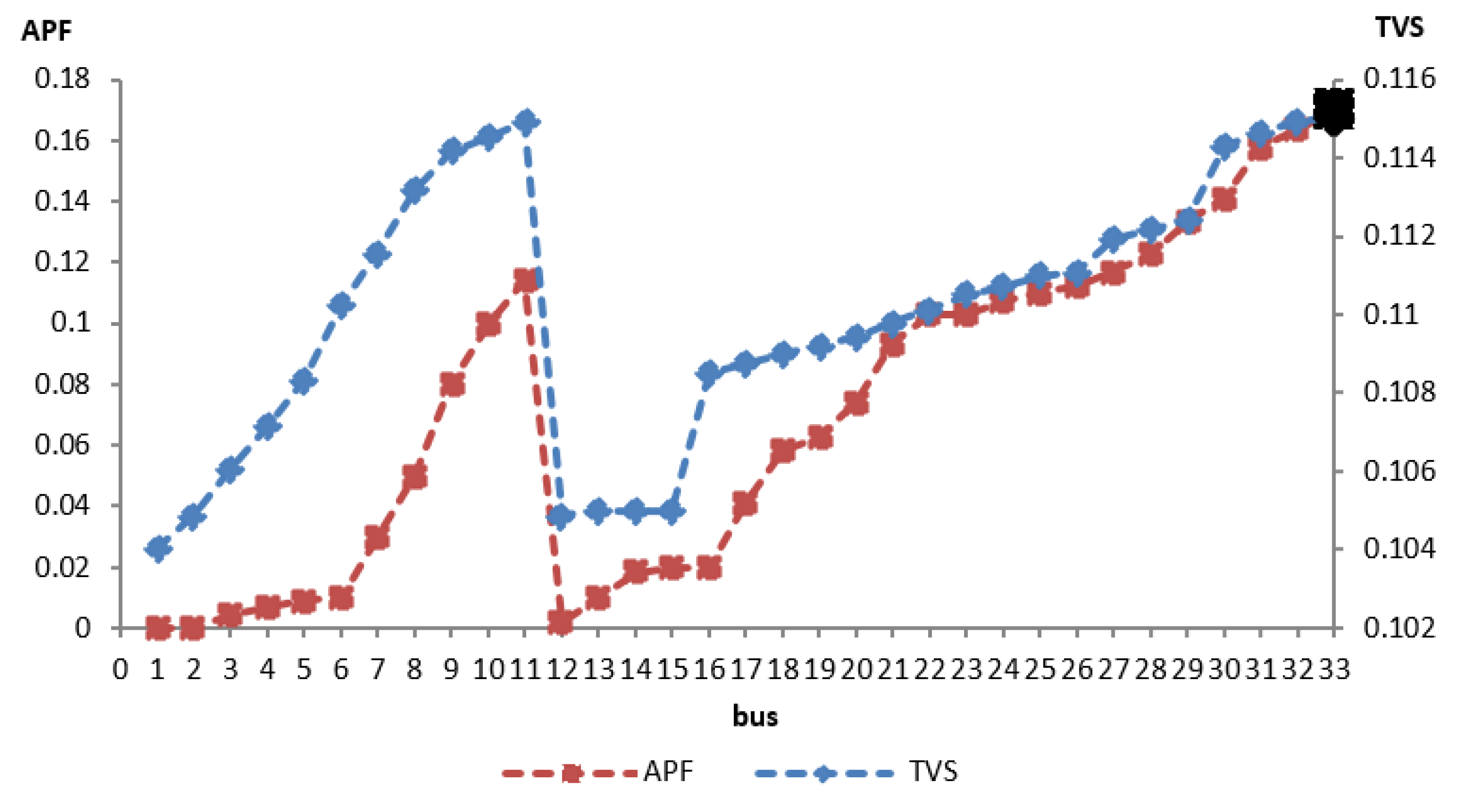
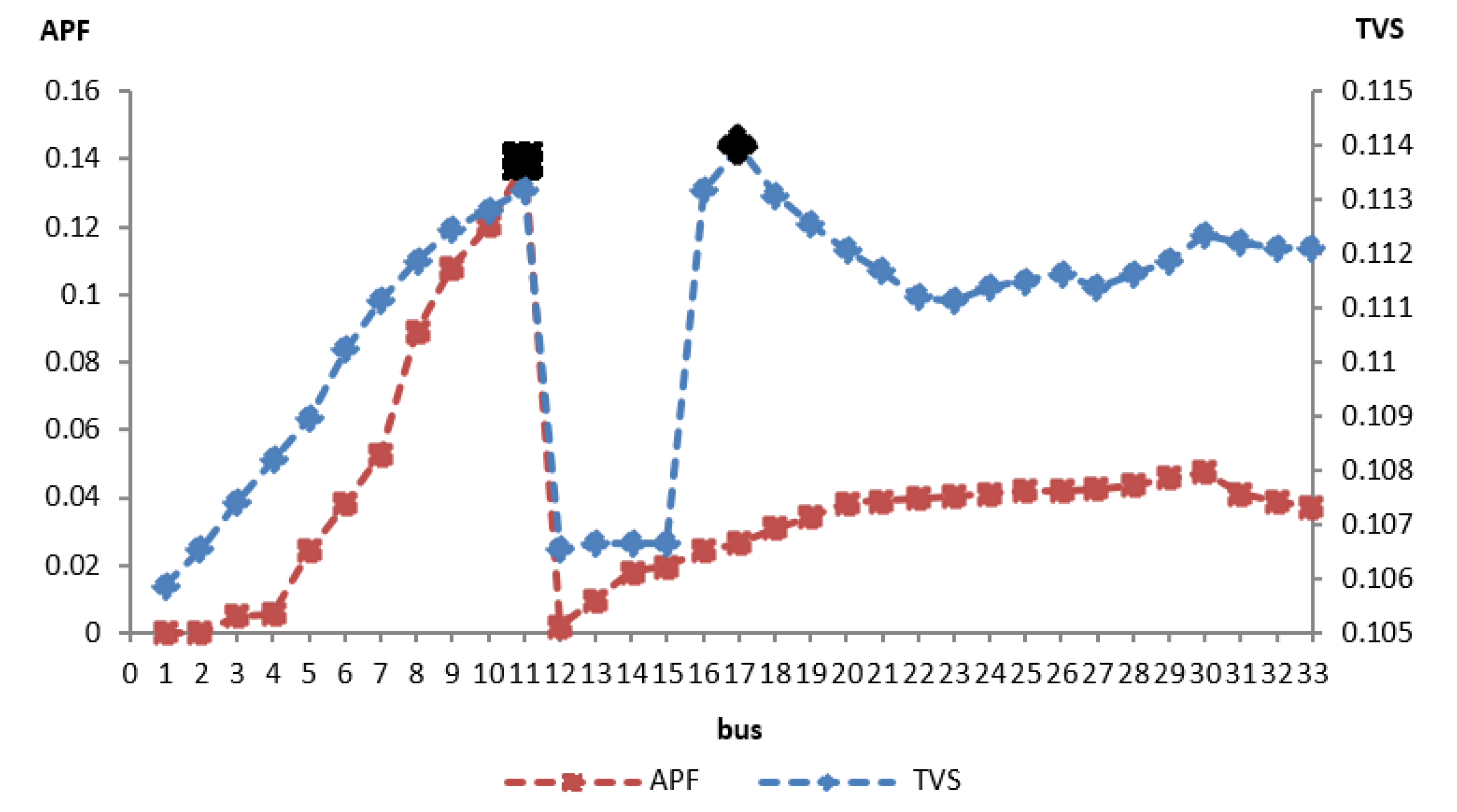
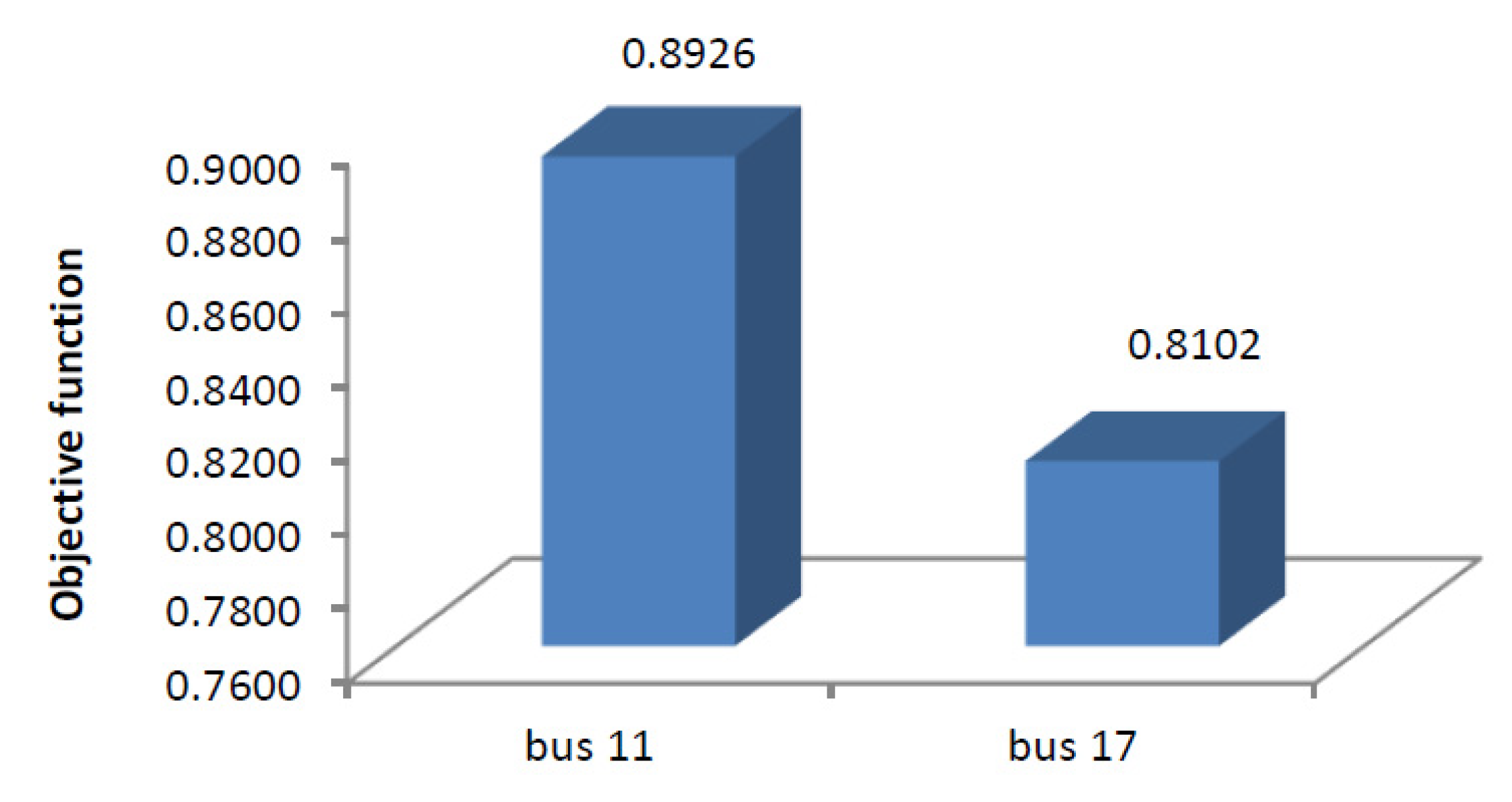
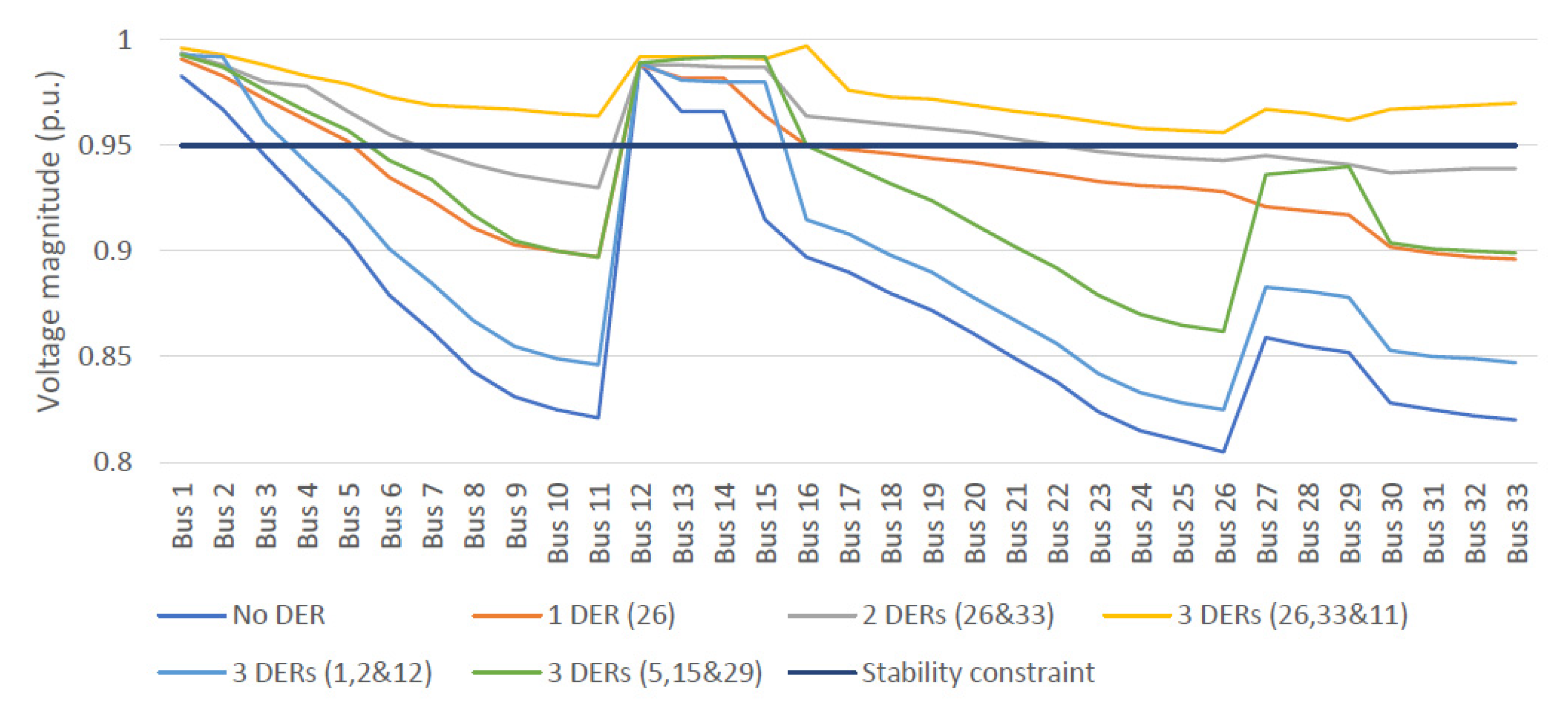
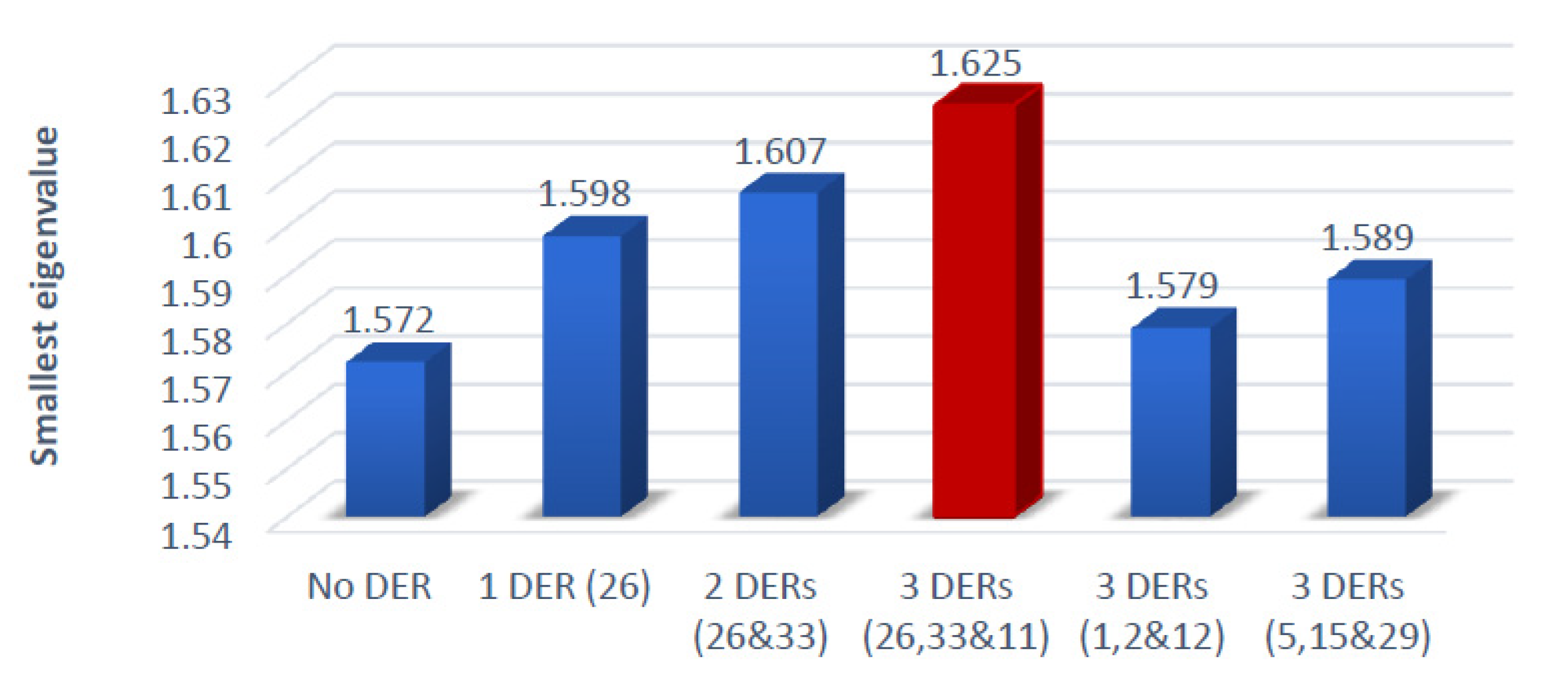
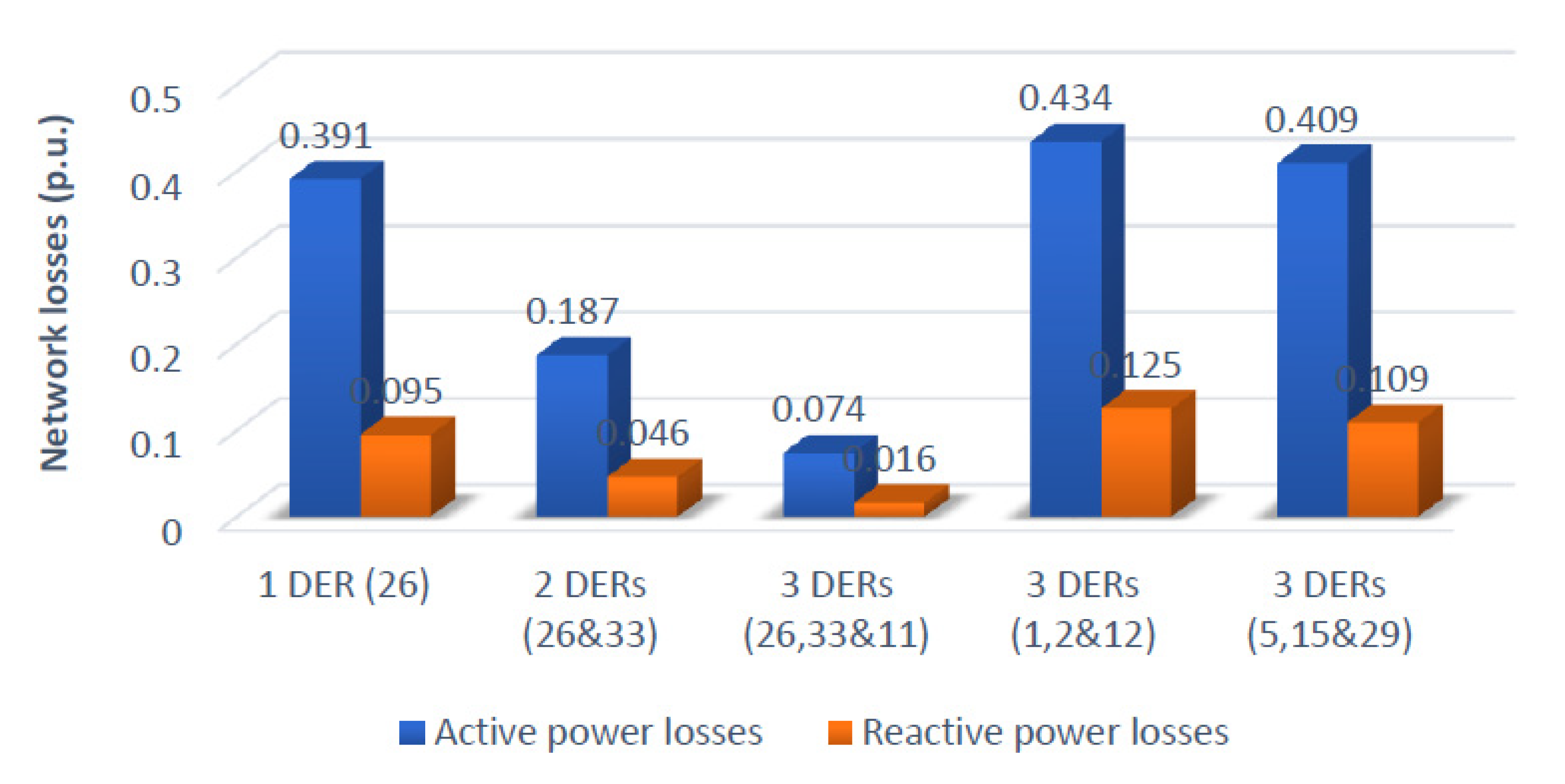
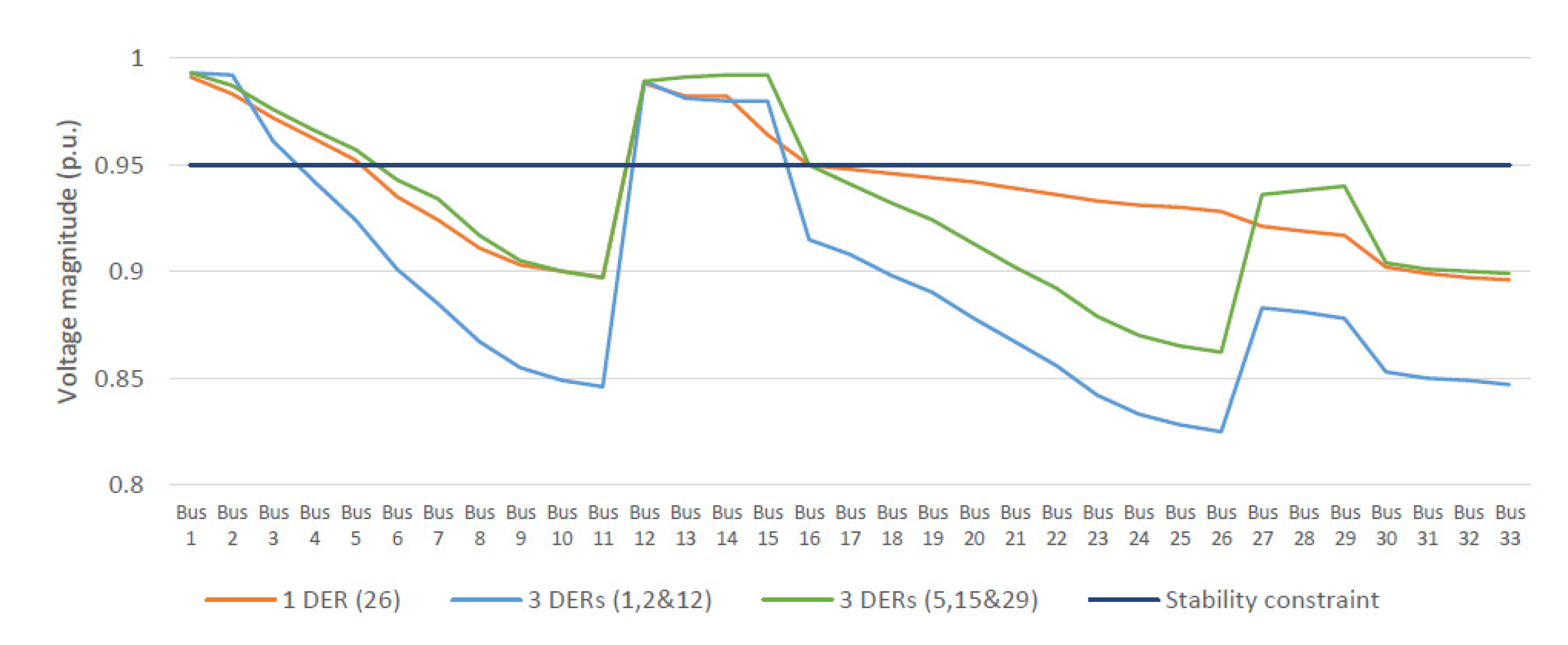
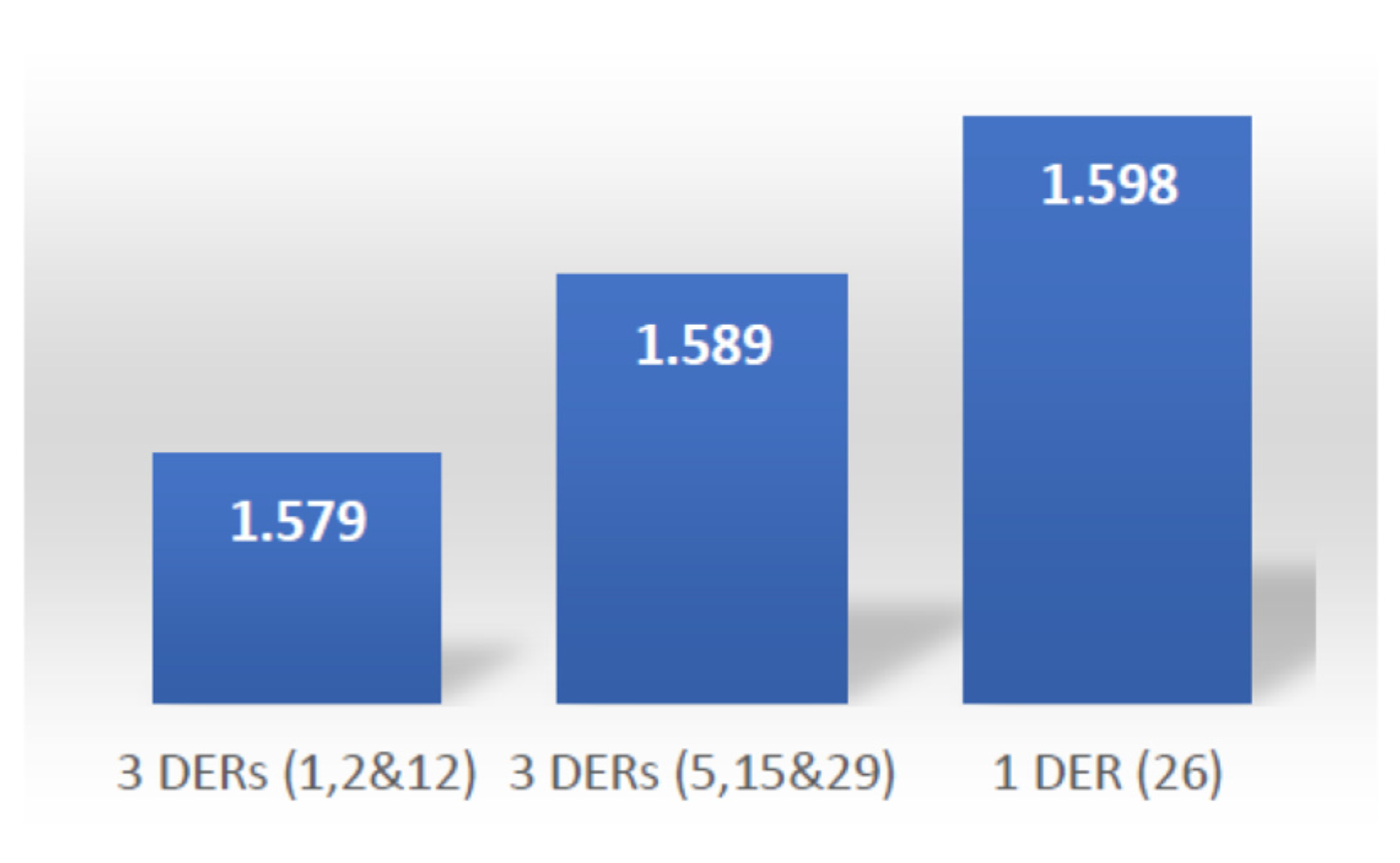
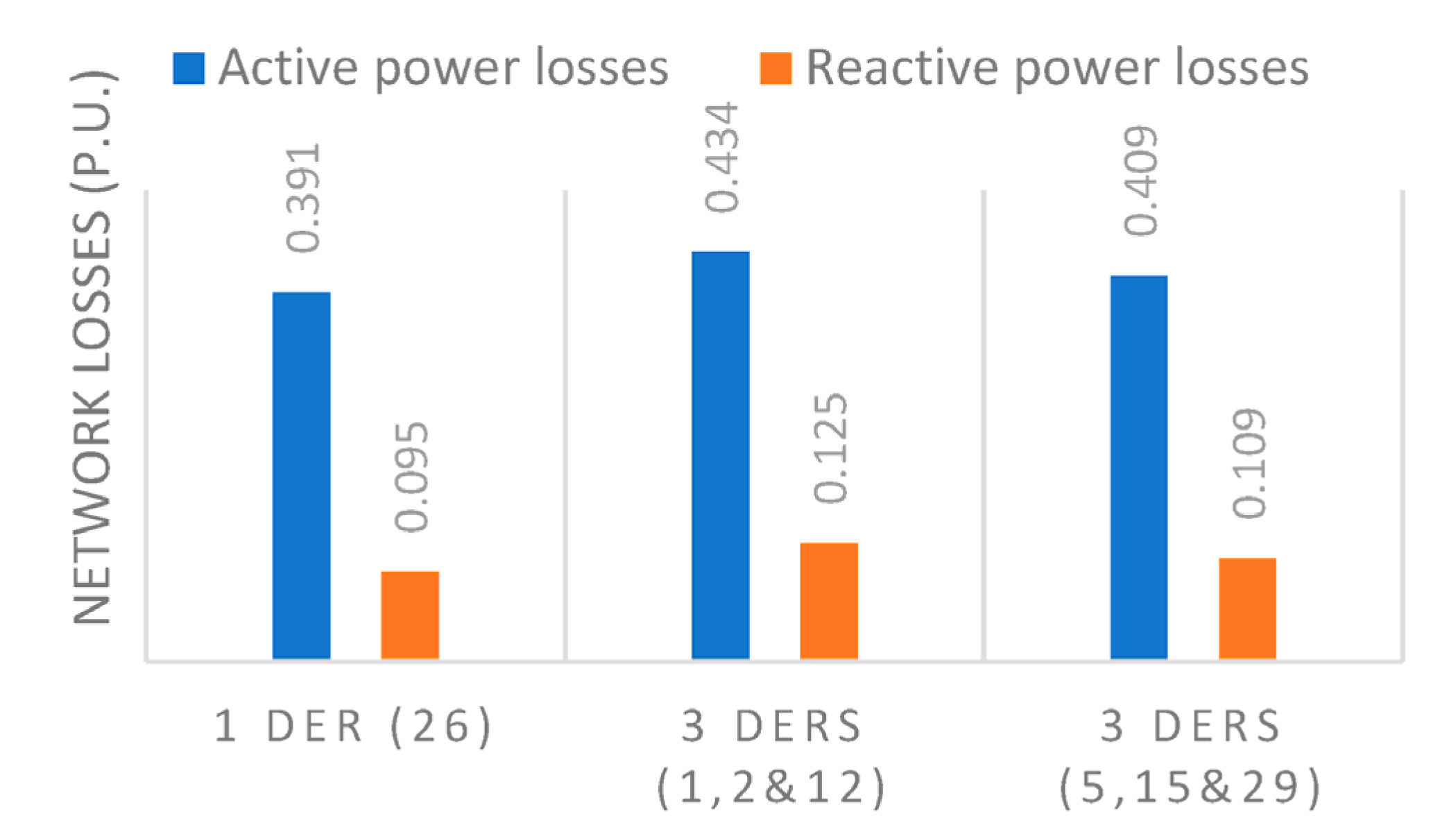

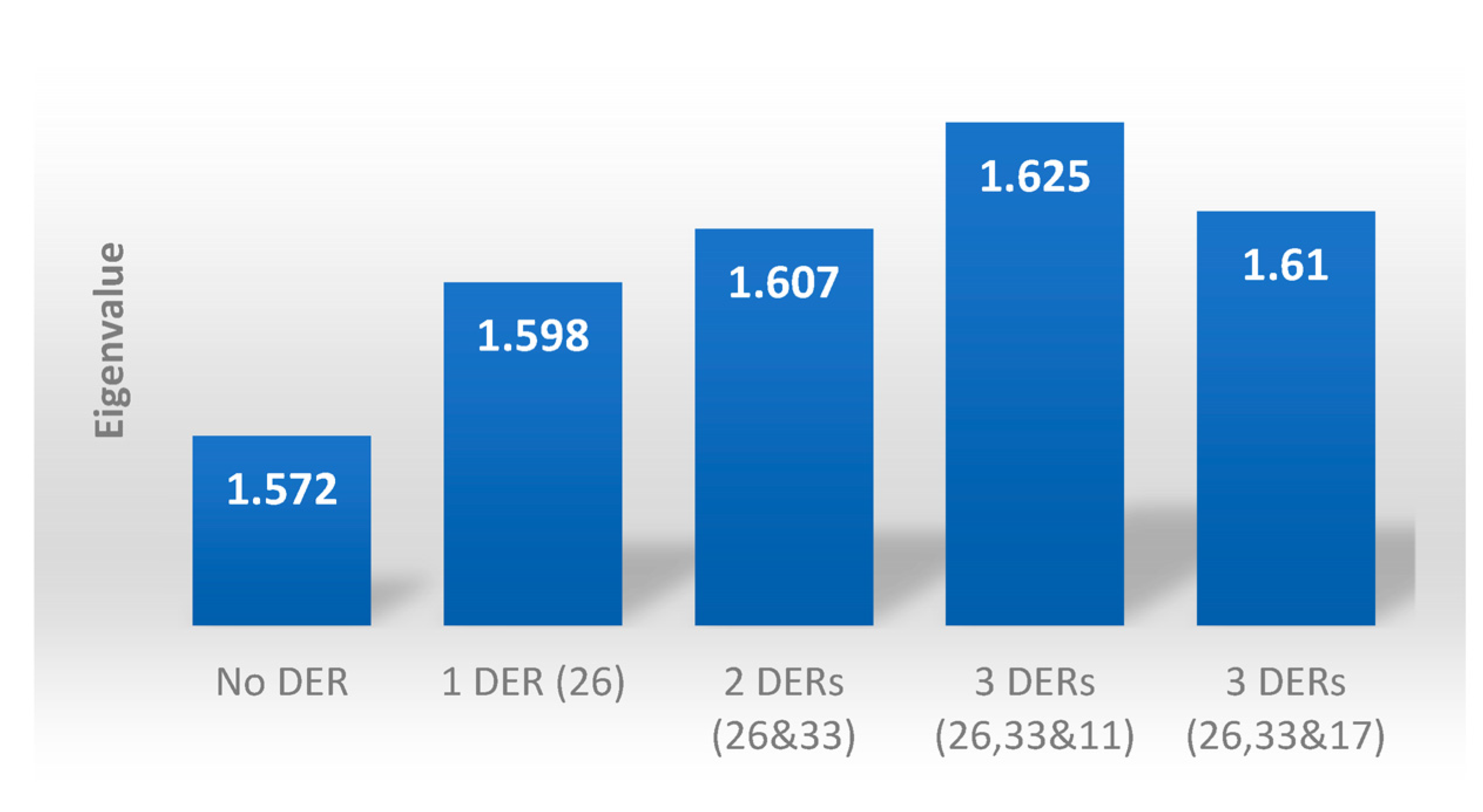
| Iteration | Highest APF | Highest TVS | Highest OF | DER Location |
|---|---|---|---|---|
| 1 | 26 | 26 | - | 26 |
| 2 | 33 | 33 | - | 33 |
| 3 | 11 | 17 | 11 | 11 |
| High Values of APF/TVS (Recommended) | Small Values of APF/TVS | Average Values of APF/TVS | |
|---|---|---|---|
| DER Locations | 26, 33, and 11 | 1, 2, and 12 | 5, 15, and 29 |
| 1.625 | 1.579 | 1.589 | |
| 42.25 | 4.44 | 7.06 | |
| 44.59 | 8.88 | 14.27 |
| Iteration | CPF Method [19] | Proposed Method Hybrid MMA–CPF |
|---|---|---|
| 1 | 26 | 26 |
| 2 | 33 | 33 |
| 3 | 17 | 11 |
| DER Placement | Approach | VSI (%) | OF | |||
|---|---|---|---|---|---|---|
| 26, 33, and 17 | CPF [19] | 1.610 | 36.36 | 41.29 | 2.430335 | 80.08033 |
| 26, 33, and 11 | MMA–CPF | 1.618 | 42.25 | 44.59 | 2.939305 | 89.77931 |
| 26 and 33 | Both | 1.6067 | 30.34 | 35.33 | 2.220384 | 67.89038 |
| 26 | Both | 1.5988 | 8.87 | 18.97 | 1.717776 | 29.55778 |
Disclaimer/Publisher’s Note: The statements, opinions and data contained in all publications are solely those of the individual author(s) and contributor(s) and not of MDPI and/or the editor(s). MDPI and/or the editor(s) disclaim responsibility for any injury to people or property resulting from any ideas, methods, instructions or products referred to in the content. |
© 2023 by the authors. Licensee MDPI, Basel, Switzerland. This article is an open access article distributed under the terms and conditions of the Creative Commons Attribution (CC BY) license (https://creativecommons.org/licenses/by/4.0/).
Share and Cite
Arief, A.; Nappu, M.B. Novel Hybrid Modified Modal Analysis and Continuation Power Flow Method for Unity Power Factor DER Placement. Energies 2023, 16, 1698. https://doi.org/10.3390/en16041698
Arief A, Nappu MB. Novel Hybrid Modified Modal Analysis and Continuation Power Flow Method for Unity Power Factor DER Placement. Energies. 2023; 16(4):1698. https://doi.org/10.3390/en16041698
Chicago/Turabian StyleArief, Ardiaty, and Muhammad Bachtiar Nappu. 2023. "Novel Hybrid Modified Modal Analysis and Continuation Power Flow Method for Unity Power Factor DER Placement" Energies 16, no. 4: 1698. https://doi.org/10.3390/en16041698







